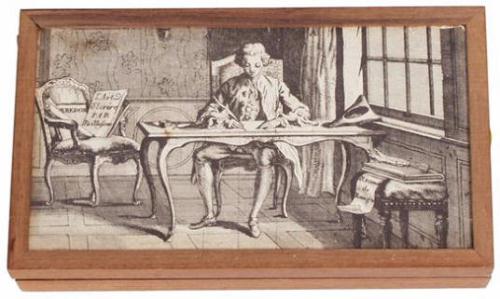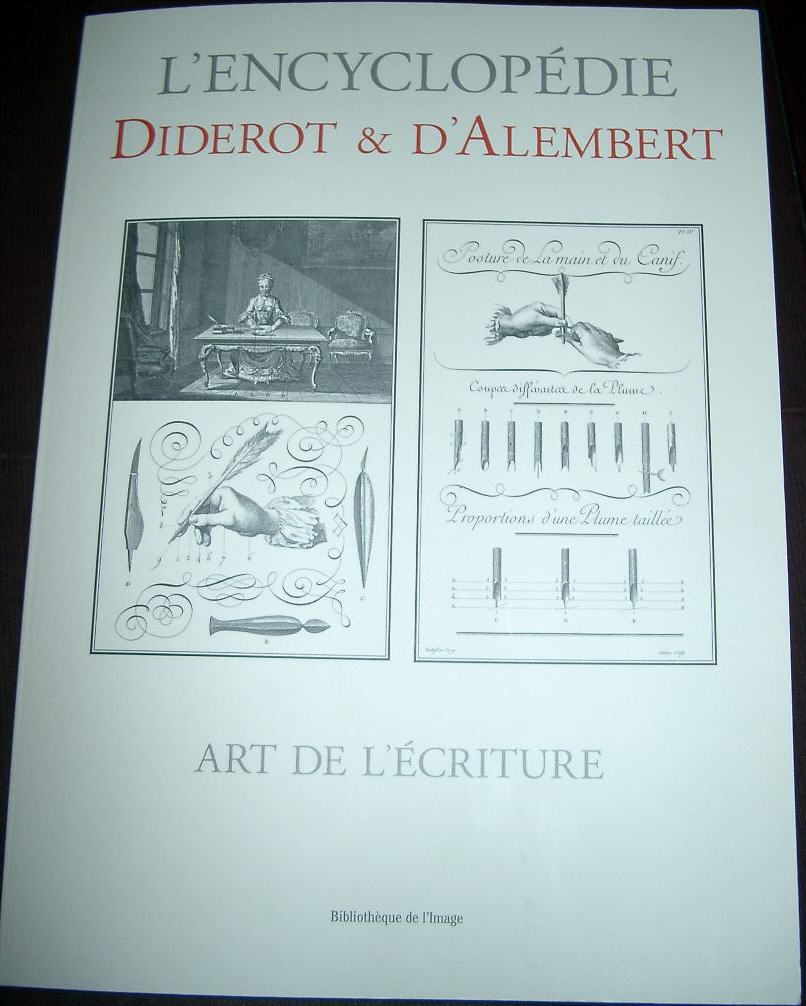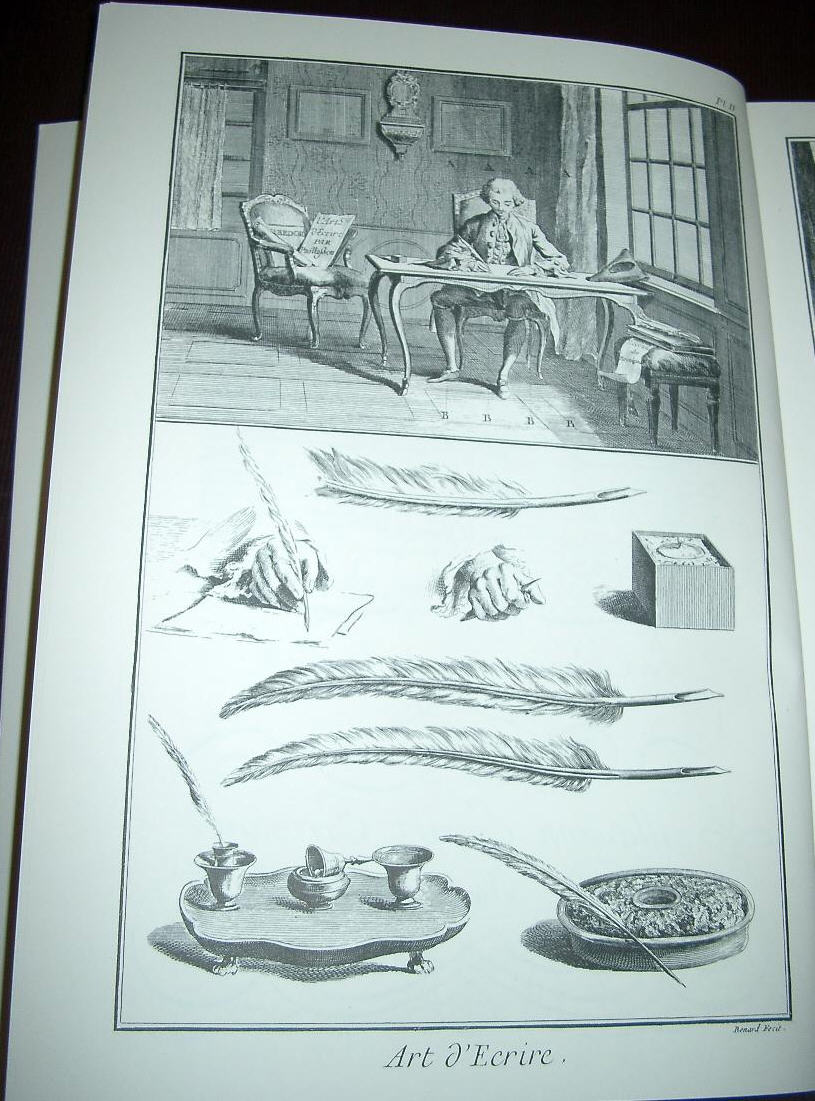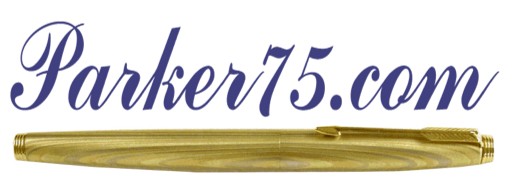A Pen Box from
the Michigan Pen Show
Copyright © 2005 Nick Olmos-Lau
I arrived late to the pre meeting trading room
of the Michigan Pen Show on September 30, 2005. It was a Friday afternoon and
there were only a handful of dealers set up with interesting items.
One item stood out, on the Parker 75 table.
It pulled my eye. It was a small wooden box. I thought I had seen before
on Lih-Tah Wong’s website.

I recognized the picture on the front of the
box. It was an old 18th C. Plate of a man sitting at a desk writing
with a quill. Next to him on another chair, nearby, there is a closed book
entitled Art d’Ecrire by Paillasson. I recognized the illustration and opened
the box. It had a beautiful illustration of French Round hand Capital letters.
The box was empty and there was no pen in it. The sign placed on the inside of
the box read: “Solid Sterling Godron with Black Cabochon. Special Box made for
the European Markets.”

I told Lee Chait that I knew where those
illustrations on the box came from, and that I was going to send him a picture
of the source upon my return home. I decided instead to write a short
article about this box and what it meant to me.
The reason I knew where those pictures came from
was a personal interest to find a good exemplar alphabet resource to learn
French Round Hand. An 18th Century alphabet that is quite attractive,
elegant and one of my favorites..
First I found a good source in Claude
Mediavilla’s Calligraphy Textbook, a French contemporary book that has a lot
of historical plates and many beautiful examples of it.
When I found the 2001 reprint of Diderot and
D’Alembert Encyclopedia volume pertaining to “The Art of
Handwriting.” I
was stunned by the extent, quality, and beauty of presentation.


The illustration of the front of Lee’s box was
a reproduction of the upper part of plate II of this volume, and the inside of
the box, has another reproduction of the lower part of plate X of Diderot and
D’Alembert Encyclopedia handwriting volume.

This stand alone volume of the Encyclopedia is a
brief booklet of about 43 pages. It was a reprint of 2001 of
a portion of the Magnum Opus by the “Biblioteque de l’Image”
The first 16 pages of text
explain each one of the subsequent 16 plates or illustrations which include:
- Introduction
- Materials and Correct Position to write for
Men
- Materials and Correct Position to write for
Women
- How to burnish and cut a quill
- How to hold the quill different approaches
- Traces and joints
- Height, width and slant of handwriting
- Preparatory exercises
- Alphabets of the Round Hand
- Alphabet of the Gothic Batarde
- Cursive alphabets
- Size of the pen and Cadels
- Capital letters
- Various styles of Round
handwriting
- Various styles of Batarde handwriting
- Various styles of Cursive writing
The next 17 pages of text are about the Ancient
Alphabets with specific examples and individual characters of Arabic, Hebrew,
Phoenician, Ethiopian and Abissinian, Samaritan and Syriac, Palmyrian and
Gallilean, Coptic and Egyptian. Greek and Arcadian, Icelandic, Anglo-Saxon,
Gothic. Illirian, Serbian, Armenian, Georgian, Persian and several others
including Bengali, Talenga, Nagrou, Siamese, Balinese, Tibetan, Tartar, Japanese
and Chinese.
It is thrilling to think that renowned
Champollion, of Rosetta Stone fame, used these charts in order to learn these
alphabets. He became the foremost
oriental Linguist of his day. Mastering a dozen languages
(some of them nearly extinct such as Coptic), accomplished through genius
instinct and intuition to unravel the thousand
years unsolved mystery of the meaning and significance of the
Egyptian Hieroglyphs.
The Encyclopédie ou Dictionnaire raisonné
des sciences, des arts et des métiers, par une Société de Gens de lettres
was published under the direction of Diderot, in 17 volumes of text and 11
volumes of plates between 1751 and 1772.
This encyclopedia is considered by some as the
main repository of human knowledge up to the 18th C. The contributors
included some of the most erudite minds of the era. Denis Diderot,
a writer and philosopher was able to garnish the manpower and effort to
propagate the content publish this work and fight the
forces that tried to obstruct it.
Jean le Rond D'Alembert, the co-editor was
a renowned mathematician, famous for explaining mathematically Newton’s
discovery of the precession of the equinoxes and perturbations of the orbits and
planets. He was able to convince Diderot of the importance of including
scientific articles in the Encyclopedia and garner such minds as Rousseau,
Voltaire, Montesquieu, Baron d'Holbach, Necker, Turgot, Buffon and many others
to collaborate.
The encyclopedia contains
72,000 articles written by more than 140 contributors, the Encyclopédie
was a massive reference work for the arts and sciences, and
technology and served to propagate the
ideas of “ The Enlightenment”.
You can freely search the
articles and plates of this encyclopedia at the U
of Chicago ARTFL project website.














